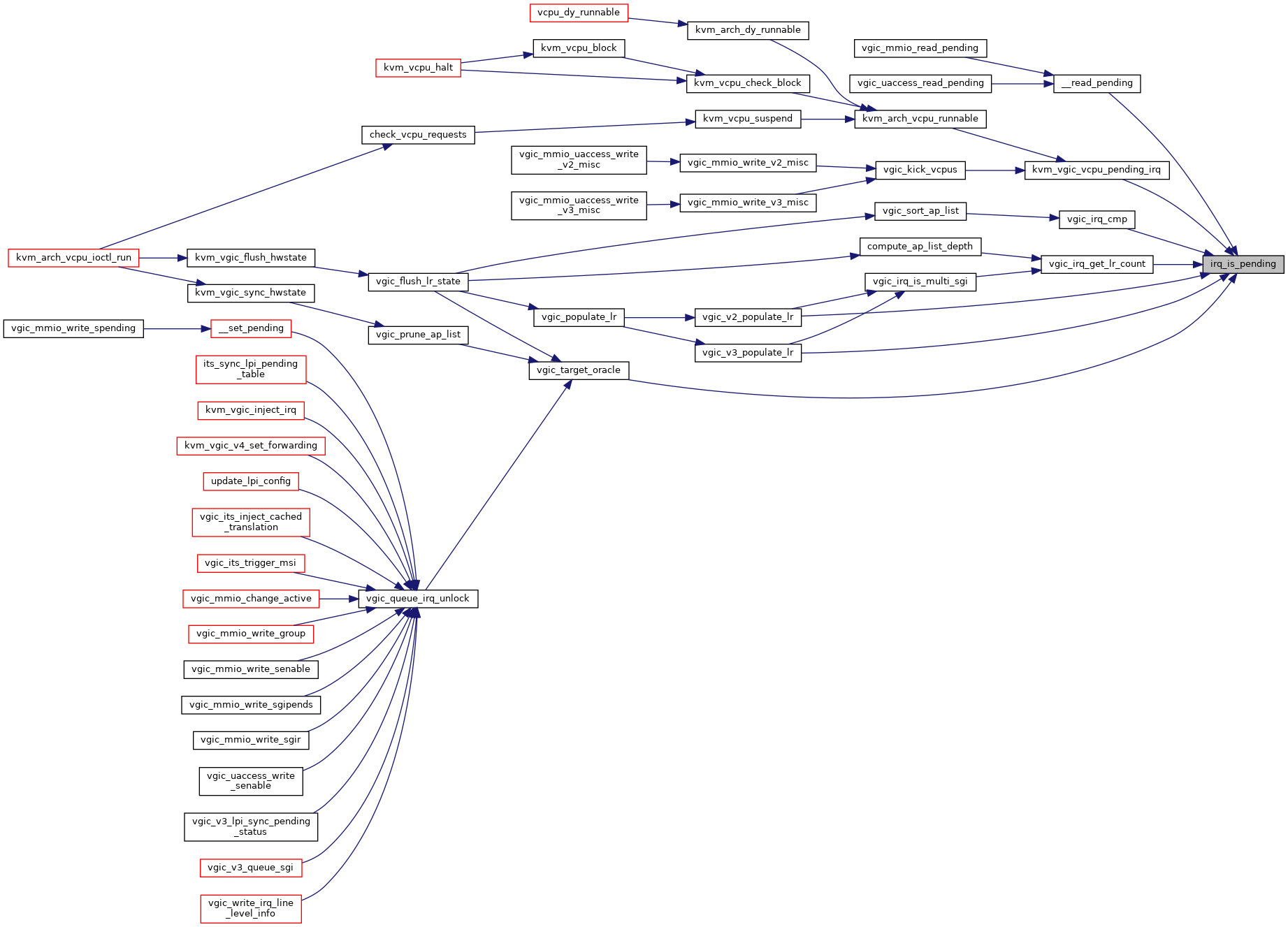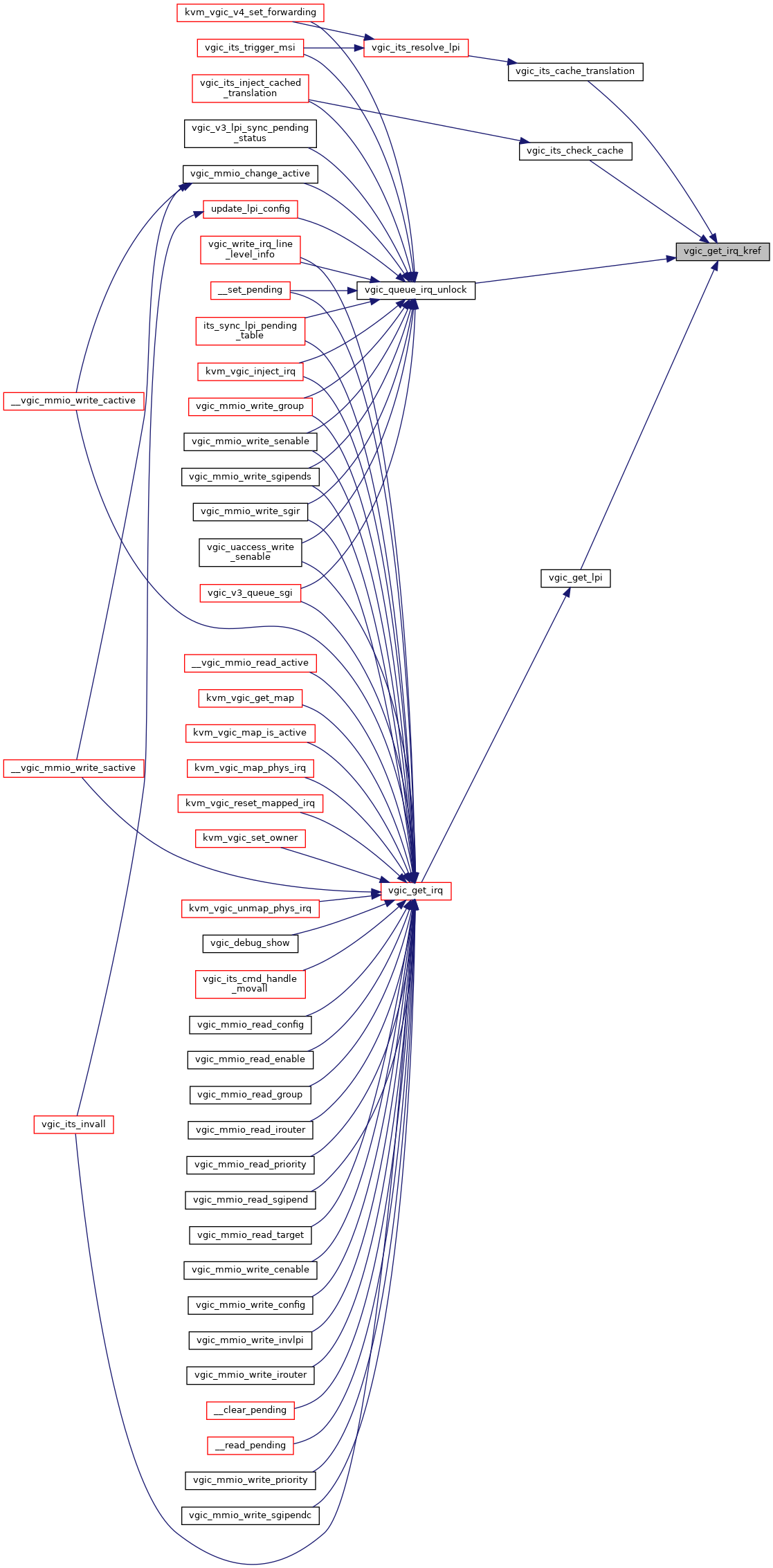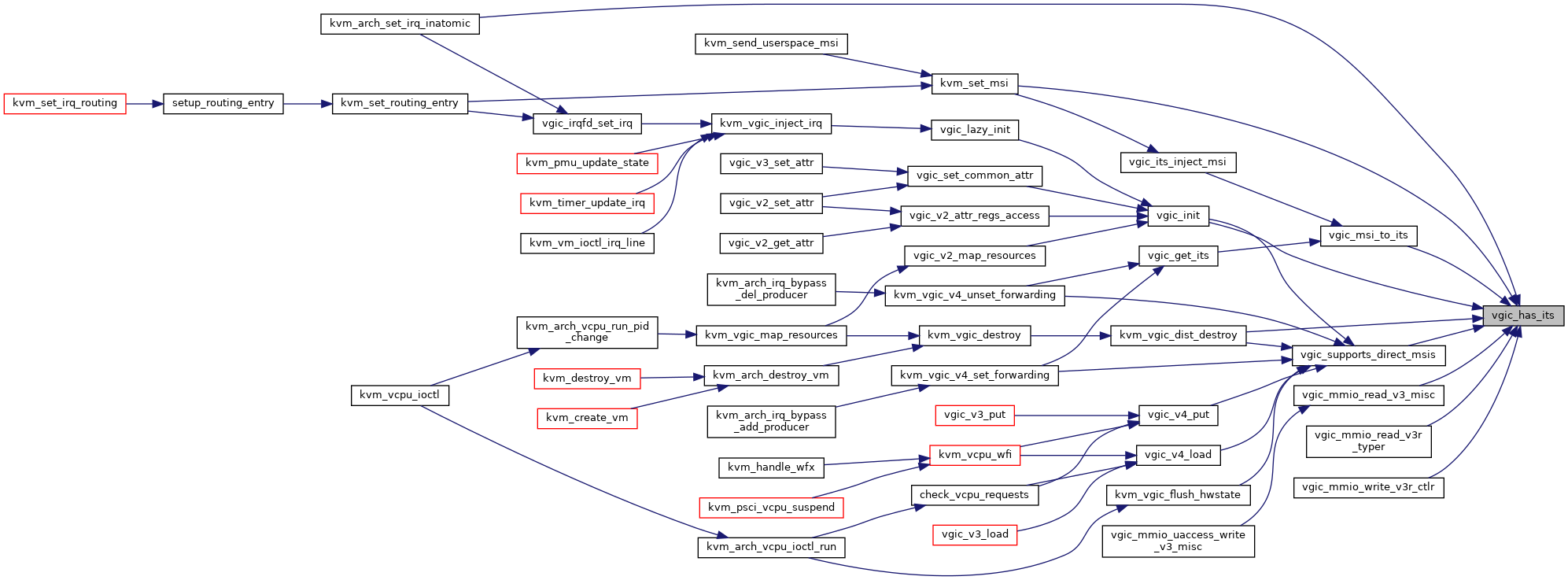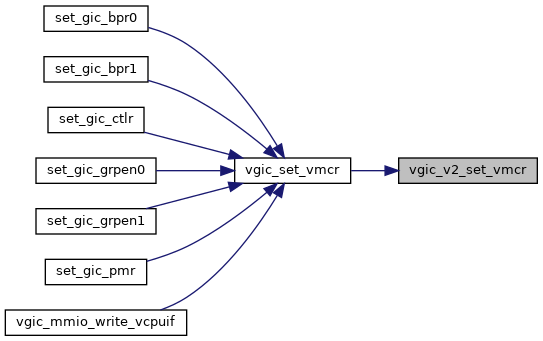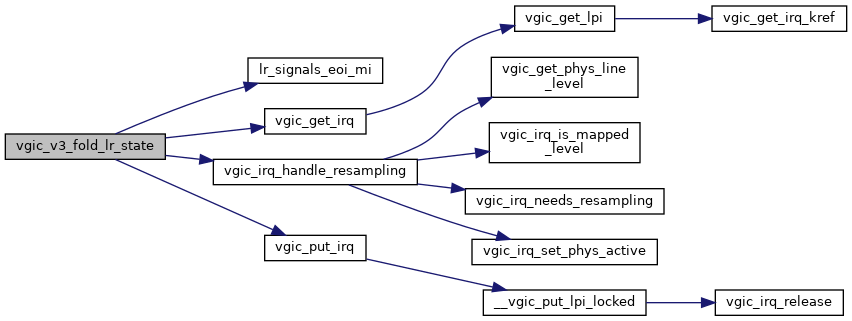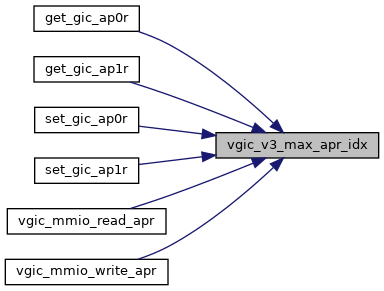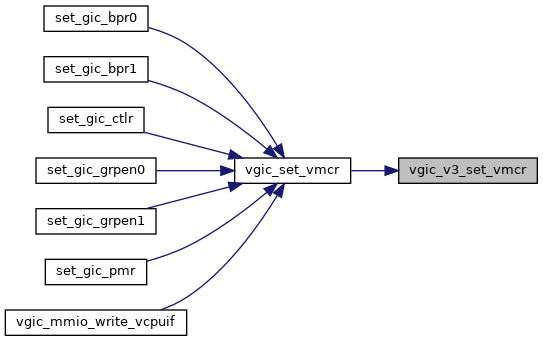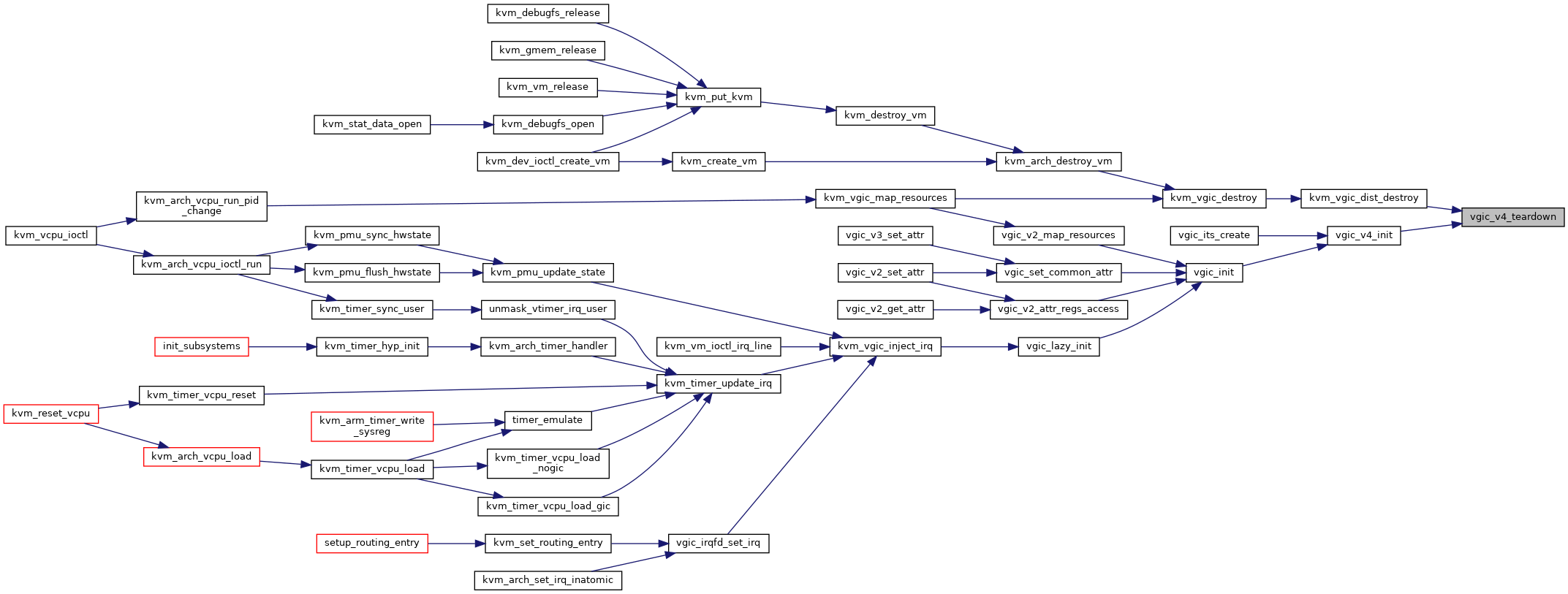#include <linux/irqchip/arm-gic-common.h>#include <asm/kvm_mmu.h>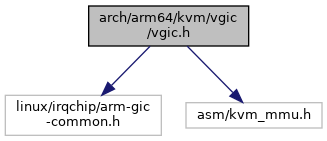

Go to the source code of this file.
Classes | |
| struct | vgic_vmcr |
| struct | vgic_reg_attr |
Functions | |
| static u32 | vgic_get_implementation_rev (struct kvm_vcpu *vcpu) |
| static bool | irq_is_pending (struct vgic_irq *irq) |
| static bool | vgic_irq_is_mapped_level (struct vgic_irq *irq) |
| static int | vgic_irq_get_lr_count (struct vgic_irq *irq) |
| static bool | vgic_irq_is_multi_sgi (struct vgic_irq *irq) |
| static int | vgic_write_guest_lock (struct kvm *kvm, gpa_t gpa, const void *data, unsigned long len) |
| int | vgic_v3_parse_attr (struct kvm_device *dev, struct kvm_device_attr *attr, struct vgic_reg_attr *reg_attr) |
| int | vgic_v2_parse_attr (struct kvm_device *dev, struct kvm_device_attr *attr, struct vgic_reg_attr *reg_attr) |
| const struct vgic_register_region * | vgic_get_mmio_region (struct kvm_vcpu *vcpu, struct vgic_io_device *iodev, gpa_t addr, int len) |
| struct vgic_irq * | vgic_get_irq (struct kvm *kvm, struct kvm_vcpu *vcpu, u32 intid) |
| void | __vgic_put_lpi_locked (struct kvm *kvm, struct vgic_irq *irq) |
| void | vgic_put_irq (struct kvm *kvm, struct vgic_irq *irq) |
| bool | vgic_get_phys_line_level (struct vgic_irq *irq) |
| void | vgic_irq_set_phys_pending (struct vgic_irq *irq, bool pending) |
| void | vgic_irq_set_phys_active (struct vgic_irq *irq, bool active) |
| bool | vgic_queue_irq_unlock (struct kvm *kvm, struct vgic_irq *irq, unsigned long flags) |
| void | vgic_kick_vcpus (struct kvm *kvm) |
| void | vgic_irq_handle_resampling (struct vgic_irq *irq, bool lr_deactivated, bool lr_pending) |
| int | vgic_check_iorange (struct kvm *kvm, phys_addr_t ioaddr, phys_addr_t addr, phys_addr_t alignment, phys_addr_t size) |
| void | vgic_v2_fold_lr_state (struct kvm_vcpu *vcpu) |
| void | vgic_v2_populate_lr (struct kvm_vcpu *vcpu, struct vgic_irq *irq, int lr) |
| void | vgic_v2_clear_lr (struct kvm_vcpu *vcpu, int lr) |
| void | vgic_v2_set_underflow (struct kvm_vcpu *vcpu) |
| int | vgic_v2_has_attr_regs (struct kvm_device *dev, struct kvm_device_attr *attr) |
| int | vgic_v2_dist_uaccess (struct kvm_vcpu *vcpu, bool is_write, int offset, u32 *val) |
| int | vgic_v2_cpuif_uaccess (struct kvm_vcpu *vcpu, bool is_write, int offset, u32 *val) |
| void | vgic_v2_set_vmcr (struct kvm_vcpu *vcpu, struct vgic_vmcr *vmcr) |
| void | vgic_v2_get_vmcr (struct kvm_vcpu *vcpu, struct vgic_vmcr *vmcr) |
| void | vgic_v2_enable (struct kvm_vcpu *vcpu) |
| int | vgic_v2_probe (const struct gic_kvm_info *info) |
| int | vgic_v2_map_resources (struct kvm *kvm) |
| int | vgic_register_dist_iodev (struct kvm *kvm, gpa_t dist_base_address, enum vgic_type) |
| void | vgic_v2_init_lrs (void) |
| void | vgic_v2_load (struct kvm_vcpu *vcpu) |
| void | vgic_v2_put (struct kvm_vcpu *vcpu) |
| void | vgic_v2_vmcr_sync (struct kvm_vcpu *vcpu) |
| void | vgic_v2_save_state (struct kvm_vcpu *vcpu) |
| void | vgic_v2_restore_state (struct kvm_vcpu *vcpu) |
| static void | vgic_get_irq_kref (struct vgic_irq *irq) |
| void | vgic_v3_fold_lr_state (struct kvm_vcpu *vcpu) |
| void | vgic_v3_populate_lr (struct kvm_vcpu *vcpu, struct vgic_irq *irq, int lr) |
| void | vgic_v3_clear_lr (struct kvm_vcpu *vcpu, int lr) |
| void | vgic_v3_set_underflow (struct kvm_vcpu *vcpu) |
| void | vgic_v3_set_vmcr (struct kvm_vcpu *vcpu, struct vgic_vmcr *vmcr) |
| void | vgic_v3_get_vmcr (struct kvm_vcpu *vcpu, struct vgic_vmcr *vmcr) |
| void | vgic_v3_enable (struct kvm_vcpu *vcpu) |
| int | vgic_v3_probe (const struct gic_kvm_info *info) |
| int | vgic_v3_map_resources (struct kvm *kvm) |
| int | vgic_v3_lpi_sync_pending_status (struct kvm *kvm, struct vgic_irq *irq) |
| int | vgic_v3_save_pending_tables (struct kvm *kvm) |
| int | vgic_v3_set_redist_base (struct kvm *kvm, u32 index, u64 addr, u32 count) |
| int | vgic_register_redist_iodev (struct kvm_vcpu *vcpu) |
| void | vgic_unregister_redist_iodev (struct kvm_vcpu *vcpu) |
| bool | vgic_v3_check_base (struct kvm *kvm) |
| void | vgic_v3_load (struct kvm_vcpu *vcpu) |
| void | vgic_v3_put (struct kvm_vcpu *vcpu) |
| void | vgic_v3_vmcr_sync (struct kvm_vcpu *vcpu) |
| bool | vgic_has_its (struct kvm *kvm) |
| int | kvm_vgic_register_its_device (void) |
| void | vgic_enable_lpis (struct kvm_vcpu *vcpu) |
| void | vgic_flush_pending_lpis (struct kvm_vcpu *vcpu) |
| int | vgic_its_inject_msi (struct kvm *kvm, struct kvm_msi *msi) |
| int | vgic_v3_has_attr_regs (struct kvm_device *dev, struct kvm_device_attr *attr) |
| int | vgic_v3_dist_uaccess (struct kvm_vcpu *vcpu, bool is_write, int offset, u32 *val) |
| int | vgic_v3_redist_uaccess (struct kvm_vcpu *vcpu, bool is_write, int offset, u32 *val) |
| int | vgic_v3_cpu_sysregs_uaccess (struct kvm_vcpu *vcpu, struct kvm_device_attr *attr, bool is_write) |
| int | vgic_v3_has_cpu_sysregs_attr (struct kvm_vcpu *vcpu, struct kvm_device_attr *attr) |
| int | vgic_v3_line_level_info_uaccess (struct kvm_vcpu *vcpu, bool is_write, u32 intid, u32 *val) |
| int | kvm_register_vgic_device (unsigned long type) |
| void | vgic_set_vmcr (struct kvm_vcpu *vcpu, struct vgic_vmcr *vmcr) |
| void | vgic_get_vmcr (struct kvm_vcpu *vcpu, struct vgic_vmcr *vmcr) |
| int | vgic_lazy_init (struct kvm *kvm) |
| int | vgic_init (struct kvm *kvm) |
| void | vgic_debug_init (struct kvm *kvm) |
| void | vgic_debug_destroy (struct kvm *kvm) |
| static int | vgic_v3_max_apr_idx (struct kvm_vcpu *vcpu) |
| static bool | vgic_v3_redist_region_full (struct vgic_redist_region *region) |
| struct vgic_redist_region * | vgic_v3_rdist_free_slot (struct list_head *rdregs) |
| static size_t | vgic_v3_rd_region_size (struct kvm *kvm, struct vgic_redist_region *rdreg) |
| struct vgic_redist_region * | vgic_v3_rdist_region_from_index (struct kvm *kvm, u32 index) |
| void | vgic_v3_free_redist_region (struct vgic_redist_region *rdreg) |
| bool | vgic_v3_rdist_overlap (struct kvm *kvm, gpa_t base, size_t size) |
| static bool | vgic_dist_overlap (struct kvm *kvm, gpa_t base, size_t size) |
| bool | vgic_lpis_enabled (struct kvm_vcpu *vcpu) |
| int | vgic_copy_lpi_list (struct kvm *kvm, struct kvm_vcpu *vcpu, u32 **intid_ptr) |
| int | vgic_its_resolve_lpi (struct kvm *kvm, struct vgic_its *its, u32 devid, u32 eventid, struct vgic_irq **irq) |
| struct vgic_its * | vgic_msi_to_its (struct kvm *kvm, struct kvm_msi *msi) |
| int | vgic_its_inject_cached_translation (struct kvm *kvm, struct kvm_msi *msi) |
| void | vgic_lpi_translation_cache_init (struct kvm *kvm) |
| void | vgic_lpi_translation_cache_destroy (struct kvm *kvm) |
| void | vgic_its_invalidate_cache (struct kvm *kvm) |
| int | vgic_its_inv_lpi (struct kvm *kvm, struct vgic_irq *irq) |
| int | vgic_its_invall (struct kvm_vcpu *vcpu) |
| bool | vgic_supports_direct_msis (struct kvm *kvm) |
| int | vgic_v4_init (struct kvm *kvm) |
| void | vgic_v4_teardown (struct kvm *kvm) |
| void | vgic_v4_configure_vsgis (struct kvm *kvm) |
| void | vgic_v4_get_vlpi_state (struct vgic_irq *irq, bool *val) |
| int | vgic_v4_request_vpe_irq (struct kvm_vcpu *vcpu, int irq) |
Macro Definition Documentation
◆ DEBUG_SPINLOCK_BUG_ON
◆ IMPLEMENTER_ARM
◆ INTERRUPT_ID_BITS_ITS
◆ INTERRUPT_ID_BITS_SPIS
◆ IS_VGIC_ADDR_UNDEF
| #define IS_VGIC_ADDR_UNDEF | ( | _x | ) | ((_x) == VGIC_ADDR_UNDEF) |
◆ KVM_DEV_ARM_VGIC_SYSREG_MASK
| #define KVM_DEV_ARM_VGIC_SYSREG_MASK |
◆ KVM_ITS_CTE_ICID_MASK
◆ KVM_ITS_CTE_RDBASE_SHIFT
◆ KVM_ITS_CTE_VALID_MASK
◆ KVM_ITS_CTE_VALID_SHIFT
◆ KVM_ITS_DTE_ITTADDR_MASK
◆ KVM_ITS_DTE_ITTADDR_SHIFT
◆ KVM_ITS_DTE_NEXT_MASK
◆ KVM_ITS_DTE_NEXT_SHIFT
◆ KVM_ITS_DTE_SIZE_MASK
◆ KVM_ITS_DTE_VALID_MASK
◆ KVM_ITS_DTE_VALID_SHIFT
◆ KVM_ITS_ITE_ICID_MASK
◆ KVM_ITS_ITE_NEXT_SHIFT
◆ KVM_ITS_ITE_PINTID_MASK
◆ KVM_ITS_ITE_PINTID_SHIFT
◆ KVM_ITS_L1E_ADDR_MASK
◆ KVM_ITS_L1E_VALID_MASK
◆ KVM_REG_ARM_VGIC_SYSREG_CRM_MASK
◆ KVM_REG_ARM_VGIC_SYSREG_CRM_SHIFT
◆ KVM_REG_ARM_VGIC_SYSREG_CRN_MASK
◆ KVM_REG_ARM_VGIC_SYSREG_CRN_SHIFT
◆ KVM_REG_ARM_VGIC_SYSREG_OP0_MASK
◆ KVM_REG_ARM_VGIC_SYSREG_OP0_SHIFT
◆ KVM_REG_ARM_VGIC_SYSREG_OP1_MASK
◆ KVM_REG_ARM_VGIC_SYSREG_OP1_SHIFT
◆ KVM_REG_ARM_VGIC_SYSREG_OP2_MASK
◆ KVM_REG_ARM_VGIC_SYSREG_OP2_SHIFT
◆ KVM_VGIC_V3_RDIST_BASE_MASK
◆ KVM_VGIC_V3_RDIST_COUNT_MASK
◆ KVM_VGIC_V3_RDIST_COUNT_SHIFT
◆ KVM_VGIC_V3_RDIST_FLAGS_MASK
◆ KVM_VGIC_V3_RDIST_FLAGS_SHIFT
◆ KVM_VGIC_V3_RDIST_INDEX_MASK
◆ PRODUCT_ID_KVM
◆ VGIC_ADDR_UNDEF
◆ VGIC_AFFINITY_0_MASK
| #define VGIC_AFFINITY_0_MASK (0xffUL << VGIC_AFFINITY_0_SHIFT) |
◆ VGIC_AFFINITY_0_SHIFT
◆ VGIC_AFFINITY_1_MASK
| #define VGIC_AFFINITY_1_MASK (0xffUL << VGIC_AFFINITY_1_SHIFT) |
◆ VGIC_AFFINITY_1_SHIFT
◆ VGIC_AFFINITY_2_MASK
| #define VGIC_AFFINITY_2_MASK (0xffUL << VGIC_AFFINITY_2_SHIFT) |
◆ VGIC_AFFINITY_2_SHIFT
◆ VGIC_AFFINITY_3_MASK
| #define VGIC_AFFINITY_3_MASK (0xffUL << VGIC_AFFINITY_3_SHIFT) |
◆ VGIC_AFFINITY_3_SHIFT
◆ VGIC_AFFINITY_LEVEL
| #define VGIC_AFFINITY_LEVEL | ( | reg, | |
| level | |||
| ) |
◆ vgic_irq_is_sgi
| #define vgic_irq_is_sgi | ( | intid | ) | ((intid) < VGIC_NR_SGIS) |
◆ VGIC_PRI_BITS
◆ VGIC_TO_MPIDR
| #define VGIC_TO_MPIDR | ( | val | ) |
Function Documentation
◆ __vgic_put_lpi_locked()
| void __vgic_put_lpi_locked | ( | struct kvm * | kvm, |
| struct vgic_irq * | irq | ||
| ) |
Definition at line 126 of file vgic.c.

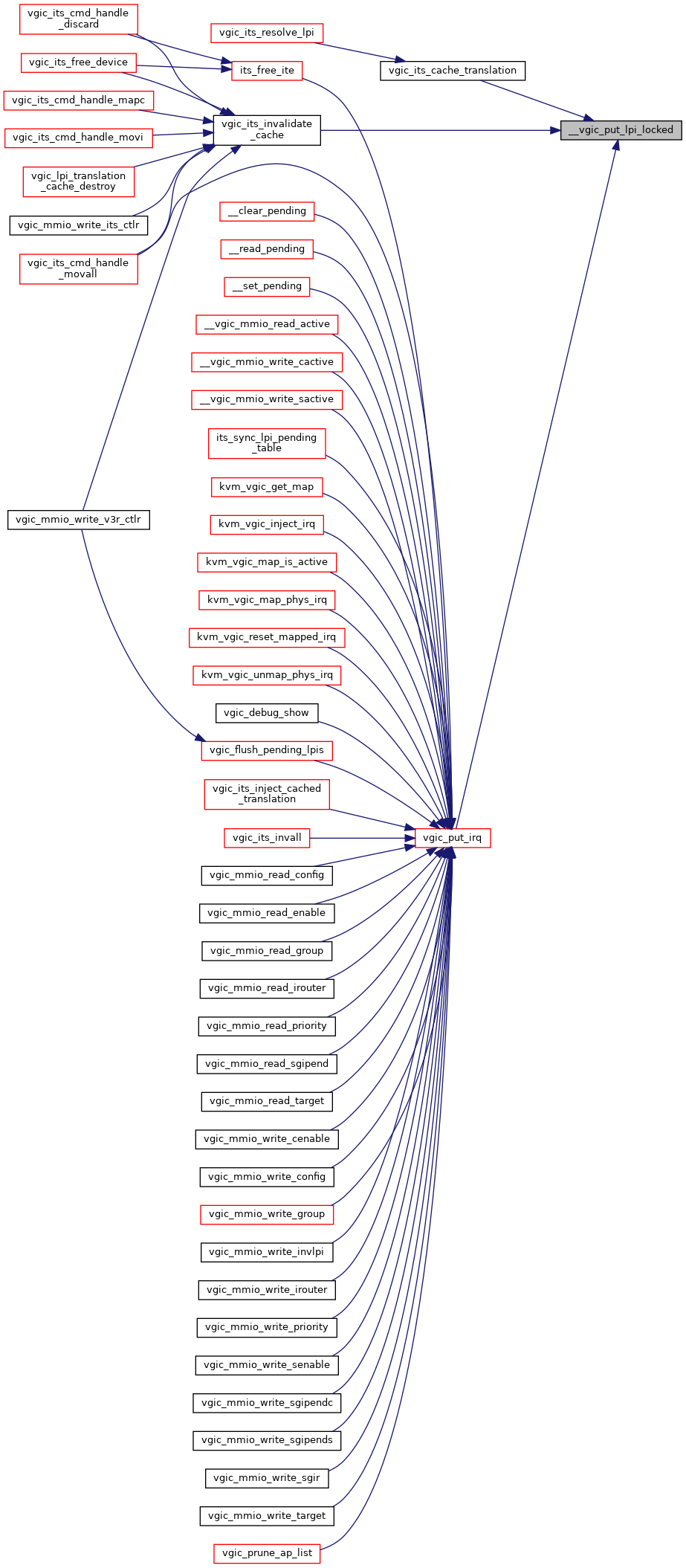
◆ irq_is_pending()
|
inlinestatic |
◆ kvm_register_vgic_device()
| int kvm_register_vgic_device | ( | unsigned long | type | ) |
Definition at line 316 of file vgic-kvm-device.c.


◆ kvm_vgic_register_its_device()
| int kvm_vgic_register_its_device | ( | void | ) |
◆ vgic_check_iorange()
| int vgic_check_iorange | ( | struct kvm * | kvm, |
| phys_addr_t | ioaddr, | ||
| phys_addr_t | addr, | ||
| phys_addr_t | alignment, | ||
| phys_addr_t | size | ||
| ) |
◆ vgic_copy_lpi_list()
| int vgic_copy_lpi_list | ( | struct kvm * | kvm, |
| struct kvm_vcpu * | vcpu, | ||
| u32 ** | intid_ptr | ||
| ) |
Definition at line 319 of file vgic-its.c.

◆ vgic_debug_destroy()
| void vgic_debug_destroy | ( | struct kvm * | kvm | ) |
◆ vgic_debug_init()
| void vgic_debug_init | ( | struct kvm * | kvm | ) |
◆ vgic_dist_overlap()
|
inlinestatic |
◆ vgic_enable_lpis()
| void vgic_enable_lpis | ( | struct kvm_vcpu * | vcpu | ) |
Definition at line 1866 of file vgic-its.c.


◆ vgic_flush_pending_lpis()
| void vgic_flush_pending_lpis | ( | struct kvm_vcpu * | vcpu | ) |
Definition at line 152 of file vgic.c.


◆ vgic_get_implementation_rev()
|
inlinestatic |
◆ vgic_get_irq()
| struct vgic_irq* vgic_get_irq | ( | struct kvm * | kvm, |
| struct kvm_vcpu * | vcpu, | ||
| u32 | intid | ||
| ) |
◆ vgic_get_irq_kref()
|
inlinestatic |
◆ vgic_get_mmio_region()
| const struct vgic_register_region* vgic_get_mmio_region | ( | struct kvm_vcpu * | vcpu, |
| struct vgic_io_device * | iodev, | ||
| gpa_t | addr, | ||
| int | len | ||
| ) |
Definition at line 950 of file vgic-mmio.c.


◆ vgic_get_phys_line_level()
| bool vgic_get_phys_line_level | ( | struct vgic_irq * | irq | ) |
◆ vgic_get_vmcr()
| void vgic_get_vmcr | ( | struct kvm_vcpu * | vcpu, |
| struct vgic_vmcr * | vmcr | ||
| ) |
Definition at line 851 of file vgic-mmio.c.


◆ vgic_has_its()
| bool vgic_has_its | ( | struct kvm * | kvm | ) |
◆ vgic_init()
| int vgic_init | ( | struct kvm * | kvm | ) |
Definition at line 262 of file vgic-init.c.
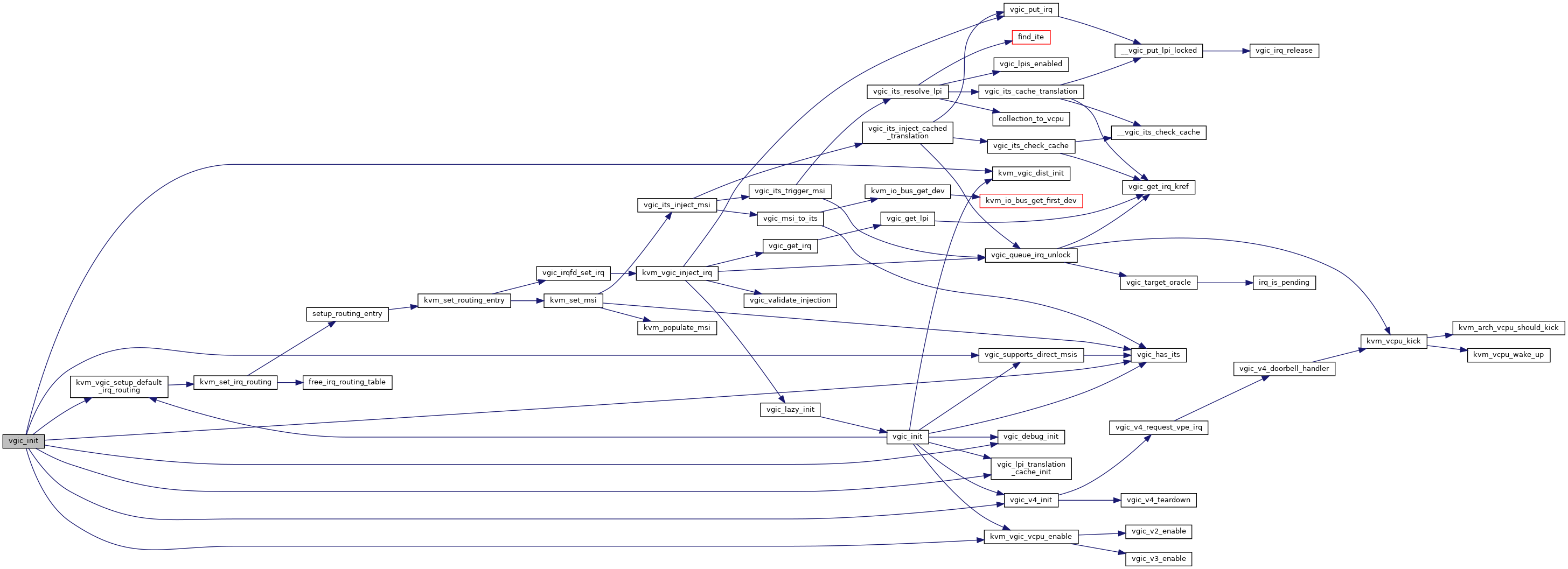

◆ vgic_irq_get_lr_count()
|
inlinestatic |
◆ vgic_irq_handle_resampling()
| void vgic_irq_handle_resampling | ( | struct vgic_irq * | irq, |
| bool | lr_deactivated, | ||
| bool | lr_pending | ||
| ) |
Definition at line 1060 of file vgic.c.
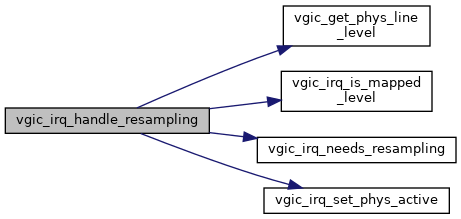

◆ vgic_irq_is_mapped_level()
|
inlinestatic |
◆ vgic_irq_is_multi_sgi()
|
inlinestatic |
◆ vgic_irq_set_phys_active()
| void vgic_irq_set_phys_active | ( | struct vgic_irq * | irq, |
| bool | active | ||
| ) |
◆ vgic_irq_set_phys_pending()
| void vgic_irq_set_phys_pending | ( | struct vgic_irq * | irq, |
| bool | pending | ||
| ) |
◆ vgic_its_inject_cached_translation()
| int vgic_its_inject_cached_translation | ( | struct kvm * | kvm, |
| struct kvm_msi * | msi | ||
| ) |
Definition at line 765 of file vgic-its.c.


◆ vgic_its_inject_msi()
| int vgic_its_inject_msi | ( | struct kvm * | kvm, |
| struct kvm_msi * | msi | ||
| ) |
Definition at line 790 of file vgic-its.c.
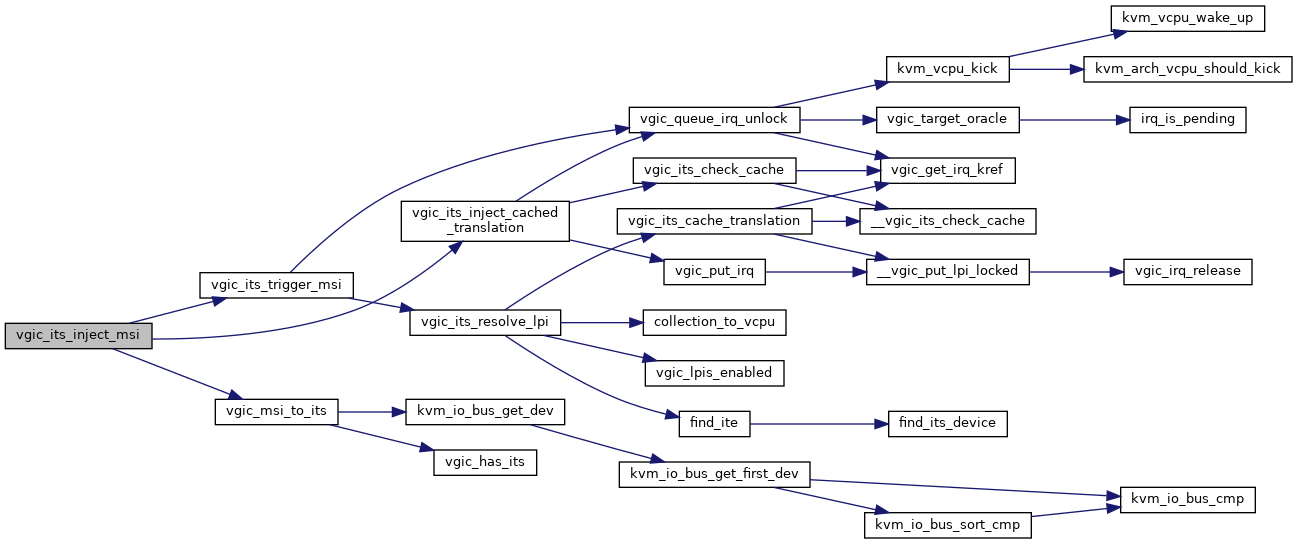

◆ vgic_its_inv_lpi()
| int vgic_its_inv_lpi | ( | struct kvm * | kvm, |
| struct vgic_irq * | irq | ||
| ) |
Definition at line 1323 of file vgic-its.c.


◆ vgic_its_invalidate_cache()
| void vgic_its_invalidate_cache | ( | struct kvm * | kvm | ) |
Definition at line 659 of file vgic-its.c.


◆ vgic_its_invall()
| int vgic_its_invall | ( | struct kvm_vcpu * | vcpu | ) |
vgic_its_invall - invalidate all LPIs targetting a given vcpu @vcpu: the vcpu for which the RD is targetted by an invalidation
Contrary to the INVALL command, this targets a RD instead of a collection, and we don't need to hold the its_lock, since no ITS is involved here.
Definition at line 1355 of file vgic-its.c.


◆ vgic_its_resolve_lpi()
| int vgic_its_resolve_lpi | ( | struct kvm * | kvm, |
| struct vgic_its * | its, | ||
| u32 | devid, | ||
| u32 | eventid, | ||
| struct vgic_irq ** | irq | ||
| ) |
Definition at line 682 of file vgic-its.c.


◆ vgic_kick_vcpus()
| void vgic_kick_vcpus | ( | struct kvm * | kvm | ) |
◆ vgic_lazy_init()
| int vgic_lazy_init | ( | struct kvm * | kvm | ) |
vgic_lazy_init: Lazy init is only allowed if the GIC exposed to the guest is a GICv2. A GICv3 must be explicitly initialized by userspace using the KVM_DEV_ARM_VGIC_GRP_CTRL KVM_DEVICE group. @kvm: kvm struct pointer
Definition at line 423 of file vgic-init.c.


◆ vgic_lpi_translation_cache_destroy()
| void vgic_lpi_translation_cache_destroy | ( | struct kvm * | kvm | ) |
Definition at line 1927 of file vgic-its.c.


◆ vgic_lpi_translation_cache_init()
| void vgic_lpi_translation_cache_init | ( | struct kvm * | kvm | ) |
◆ vgic_lpis_enabled()
| bool vgic_lpis_enabled | ( | struct kvm_vcpu * | vcpu | ) |
◆ vgic_msi_to_its()
| struct vgic_its* vgic_msi_to_its | ( | struct kvm * | kvm, |
| struct kvm_msi * | msi | ||
| ) |
Definition at line 708 of file vgic-its.c.


◆ vgic_put_irq()
| void vgic_put_irq | ( | struct kvm * | kvm, |
| struct vgic_irq * | irq | ||
| ) |
◆ vgic_queue_irq_unlock()
| bool vgic_queue_irq_unlock | ( | struct kvm * | kvm, |
| struct vgic_irq * | irq, | ||
| unsigned long | flags | ||
| ) |
Definition at line 336 of file vgic.c.

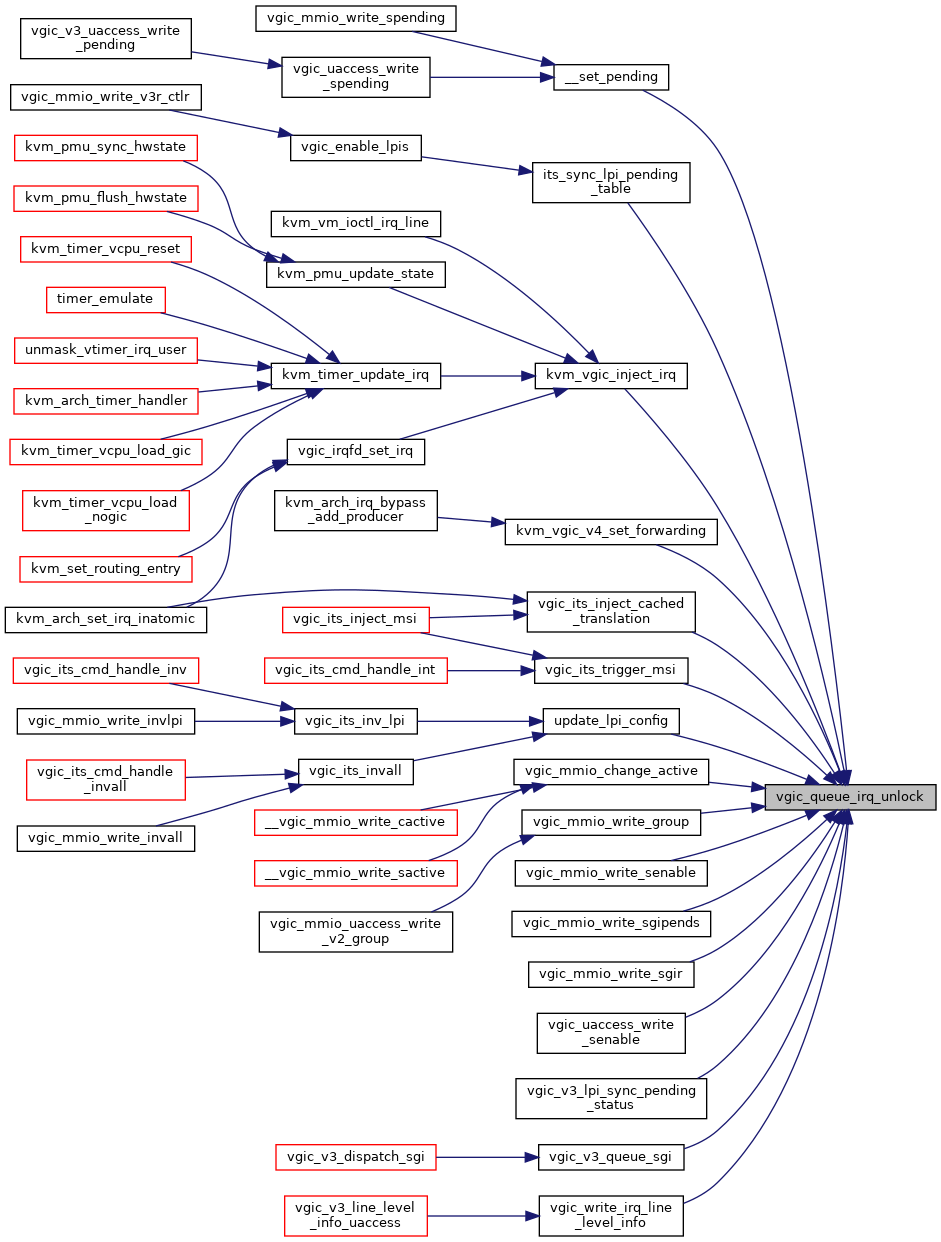
◆ vgic_register_dist_iodev()
| int vgic_register_dist_iodev | ( | struct kvm * | kvm, |
| gpa_t | dist_base_address, | ||
| enum | vgic_type | ||
| ) |
Definition at line 1080 of file vgic-mmio.c.


◆ vgic_register_redist_iodev()
| int vgic_register_redist_iodev | ( | struct kvm_vcpu * | vcpu | ) |
vgic_register_redist_iodev - register a single redist iodev @vcpu: The VCPU to which the redistributor belongs
Register a KVM iodev for this VCPU's redistributor using the address provided.
Return 0 on success, -ERRNO otherwise.
Definition at line 746 of file vgic-mmio-v3.c.


◆ vgic_set_vmcr()
| void vgic_set_vmcr | ( | struct kvm_vcpu * | vcpu, |
| struct vgic_vmcr * | vmcr | ||
| ) |
Definition at line 843 of file vgic-mmio.c.

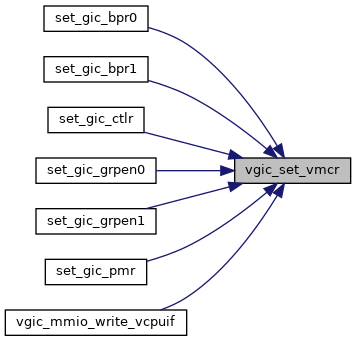
◆ vgic_supports_direct_msis()
| bool vgic_supports_direct_msis | ( | struct kvm * | kvm | ) |
Definition at line 51 of file vgic-mmio-v3.c.

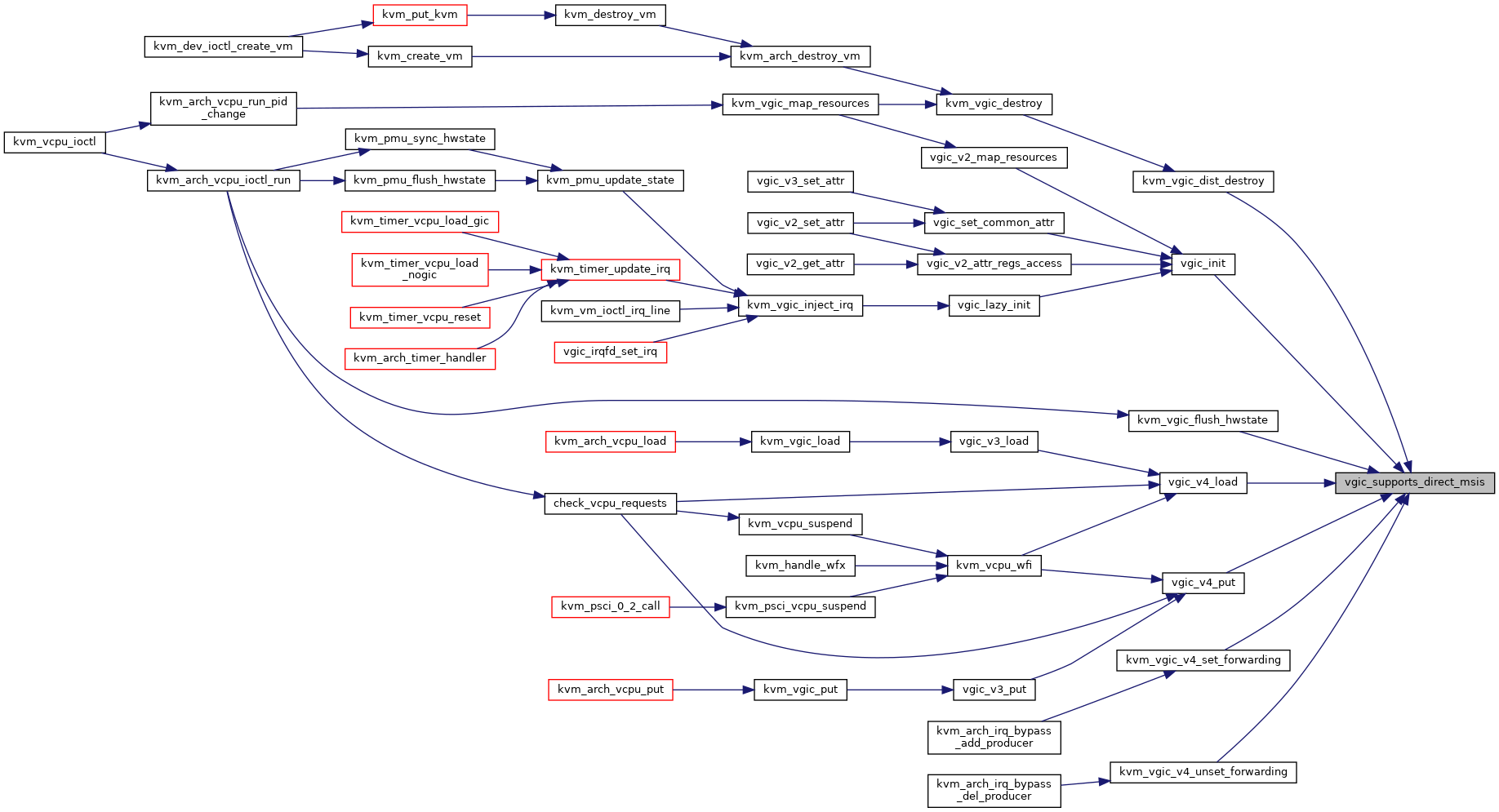
◆ vgic_unregister_redist_iodev()
| void vgic_unregister_redist_iodev | ( | struct kvm_vcpu * | vcpu | ) |
Definition at line 805 of file vgic-mmio-v3.c.


◆ vgic_v2_clear_lr()
| void vgic_v2_clear_lr | ( | struct kvm_vcpu * | vcpu, |
| int | lr | ||
| ) |
◆ vgic_v2_cpuif_uaccess()
| int vgic_v2_cpuif_uaccess | ( | struct kvm_vcpu * | vcpu, |
| bool | is_write, | ||
| int | offset, | ||
| u32 * | val | ||
| ) |
Definition at line 539 of file vgic-mmio-v2.c.


◆ vgic_v2_dist_uaccess()
| int vgic_v2_dist_uaccess | ( | struct kvm_vcpu * | vcpu, |
| bool | is_write, | ||
| int | offset, | ||
| u32 * | val | ||
| ) |
Definition at line 551 of file vgic-mmio-v2.c.


◆ vgic_v2_enable()
| void vgic_v2_enable | ( | struct kvm_vcpu * | vcpu | ) |
◆ vgic_v2_fold_lr_state()
| void vgic_v2_fold_lr_state | ( | struct kvm_vcpu * | vcpu | ) |
Definition at line 49 of file vgic-v2.c.
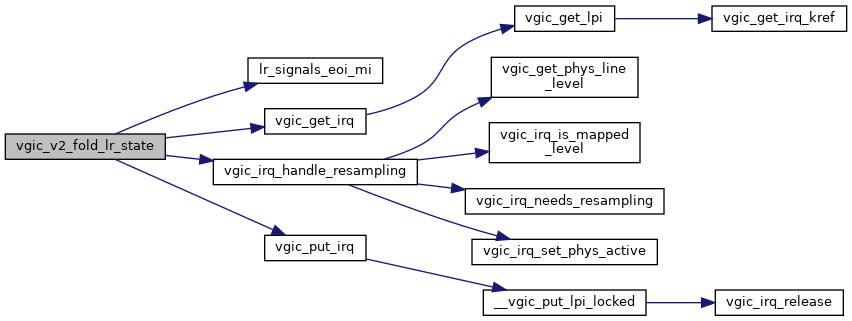

◆ vgic_v2_get_vmcr()
| void vgic_v2_get_vmcr | ( | struct kvm_vcpu * | vcpu, |
| struct vgic_vmcr * | vmcr | ||
| ) |
◆ vgic_v2_has_attr_regs()
| int vgic_v2_has_attr_regs | ( | struct kvm_device * | dev, |
| struct kvm_device_attr * | attr | ||
| ) |
Definition at line 497 of file vgic-mmio-v2.c.

◆ vgic_v2_init_lrs()
| void vgic_v2_init_lrs | ( | void | ) |
◆ vgic_v2_load()
| void vgic_v2_load | ( | struct kvm_vcpu * | vcpu | ) |
◆ vgic_v2_map_resources()
| int vgic_v2_map_resources | ( | struct kvm * | kvm | ) |
Definition at line 289 of file vgic-v2.c.


◆ vgic_v2_parse_attr()
| int vgic_v2_parse_attr | ( | struct kvm_device * | dev, |
| struct kvm_device_attr * | attr, | ||
| struct vgic_reg_attr * | reg_attr | ||
| ) |
◆ vgic_v2_populate_lr()
| void vgic_v2_populate_lr | ( | struct kvm_vcpu * | vcpu, |
| struct vgic_irq * | irq, | ||
| int | lr | ||
| ) |
◆ vgic_v2_probe()
| int vgic_v2_probe | ( | const struct gic_kvm_info * | info | ) |
vgic_v2_probe - probe for a VGICv2 compatible interrupt controller @info: pointer to the GIC description
Returns 0 if the VGICv2 has been probed successfully, returns an error code otherwise
Definition at line 337 of file vgic-v2.c.


◆ vgic_v2_put()
| void vgic_v2_put | ( | struct kvm_vcpu * | vcpu | ) |
◆ vgic_v2_restore_state()
| void vgic_v2_restore_state | ( | struct kvm_vcpu * | vcpu | ) |
◆ vgic_v2_save_state()
| void vgic_v2_save_state | ( | struct kvm_vcpu * | vcpu | ) |
◆ vgic_v2_set_underflow()
| void vgic_v2_set_underflow | ( | struct kvm_vcpu * | vcpu | ) |
◆ vgic_v2_set_vmcr()
| void vgic_v2_set_vmcr | ( | struct kvm_vcpu * | vcpu, |
| struct vgic_vmcr * | vmcr | ||
| ) |
◆ vgic_v2_vmcr_sync()
| void vgic_v2_vmcr_sync | ( | struct kvm_vcpu * | vcpu | ) |
◆ vgic_v3_check_base()
| bool vgic_v3_check_base | ( | struct kvm * | kvm | ) |
Definition at line 477 of file vgic-v3.c.


◆ vgic_v3_clear_lr()
| void vgic_v3_clear_lr | ( | struct kvm_vcpu * | vcpu, |
| int | lr | ||
| ) |
◆ vgic_v3_cpu_sysregs_uaccess()
| int vgic_v3_cpu_sysregs_uaccess | ( | struct kvm_vcpu * | vcpu, |
| struct kvm_device_attr * | attr, | ||
| bool | is_write | ||
| ) |
Definition at line 351 of file vgic-sys-reg-v3.c.


◆ vgic_v3_dist_uaccess()
| int vgic_v3_dist_uaccess | ( | struct kvm_vcpu * | vcpu, |
| bool | is_write, | ||
| int | offset, | ||
| u32 * | val | ||
| ) |
Definition at line 1095 of file vgic-mmio-v3.c.


◆ vgic_v3_enable()
| void vgic_v3_enable | ( | struct kvm_vcpu * | vcpu | ) |
Definition at line 260 of file vgic-v3.c.

◆ vgic_v3_fold_lr_state()
| void vgic_v3_fold_lr_state | ( | struct kvm_vcpu * | vcpu | ) |
◆ vgic_v3_free_redist_region()
| void vgic_v3_free_redist_region | ( | struct vgic_redist_region * | rdreg | ) |
◆ vgic_v3_get_vmcr()
| void vgic_v3_get_vmcr | ( | struct kvm_vcpu * | vcpu, |
| struct vgic_vmcr * | vmcr | ||
| ) |
◆ vgic_v3_has_attr_regs()
| int vgic_v3_has_attr_regs | ( | struct kvm_device * | dev, |
| struct kvm_device_attr * | attr | ||
| ) |
Definition at line 956 of file vgic-mmio-v3.c.

◆ vgic_v3_has_cpu_sysregs_attr()
| int vgic_v3_has_cpu_sysregs_attr | ( | struct kvm_vcpu * | vcpu, |
| struct kvm_device_attr * | attr | ||
| ) |
Definition at line 342 of file vgic-sys-reg-v3.c.


◆ vgic_v3_line_level_info_uaccess()
| int vgic_v3_line_level_info_uaccess | ( | struct kvm_vcpu * | vcpu, |
| bool | is_write, | ||
| u32 | intid, | ||
| u32 * | val | ||
| ) |
Definition at line 1117 of file vgic-mmio-v3.c.


◆ vgic_v3_load()
| void vgic_v3_load | ( | struct kvm_vcpu * | vcpu | ) |
Definition at line 720 of file vgic-v3.c.


◆ vgic_v3_lpi_sync_pending_status()
| int vgic_v3_lpi_sync_pending_status | ( | struct kvm * | kvm, |
| struct vgic_irq * | irq | ||
| ) |
Definition at line 305 of file vgic-v3.c.

◆ vgic_v3_map_resources()
| int vgic_v3_map_resources | ( | struct kvm * | kvm | ) |
◆ vgic_v3_max_apr_idx()
|
inlinestatic |
◆ vgic_v3_parse_attr()
| int vgic_v3_parse_attr | ( | struct kvm_device * | dev, |
| struct kvm_device_attr * | attr, | ||
| struct vgic_reg_attr * | reg_attr | ||
| ) |
Definition at line 474 of file vgic-kvm-device.c.


◆ vgic_v3_populate_lr()
| void vgic_v3_populate_lr | ( | struct kvm_vcpu * | vcpu, |
| struct vgic_irq * | irq, | ||
| int | lr | ||
| ) |
◆ vgic_v3_probe()
| int vgic_v3_probe | ( | const struct gic_kvm_info * | info | ) |
vgic_v3_probe - probe for a VGICv3 compatible interrupt controller @info: pointer to the GIC description
Returns 0 if the VGICv3 has been probed successfully, returns an error code otherwise
Definition at line 632 of file vgic-v3.c.
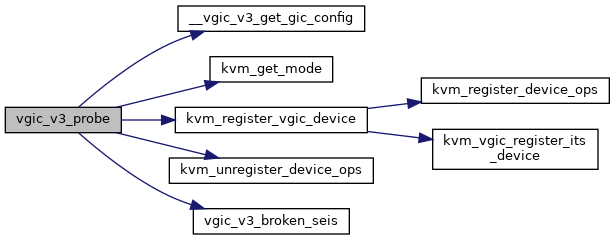

◆ vgic_v3_put()
| void vgic_v3_put | ( | struct kvm_vcpu * | vcpu | ) |
Definition at line 748 of file vgic-v3.c.


◆ vgic_v3_rd_region_size()
|
inlinestatic |
◆ vgic_v3_rdist_free_slot()
| struct vgic_redist_region* vgic_v3_rdist_free_slot | ( | struct list_head * | rd_regions | ) |
vgic_v3_rdist_free_slot - Look up registered rdist regions and identify one which has free space to put a new rdist region.
@rd_regions: redistributor region list head
A redistributor regions maps n redistributors, n = region size / (2 x 64kB). Stride between redistributors is 0 and regions are filled in the index order.
Return: the redist region handle, if any, that has space to map a new rdist region.
Definition at line 513 of file vgic-v3.c.


◆ vgic_v3_rdist_overlap()
| bool vgic_v3_rdist_overlap | ( | struct kvm * | kvm, |
| gpa_t | base, | ||
| size_t | size | ||
| ) |
vgic_v3_rdist_overlap - check if a region overlaps with any existing redistributor region
@kvm: kvm handle @base: base of the region @size: size of region
Return: true if there is an overlap
Definition at line 460 of file vgic-v3.c.


◆ vgic_v3_rdist_region_from_index()
| struct vgic_redist_region* vgic_v3_rdist_region_from_index | ( | struct kvm * | kvm, |
| u32 | index | ||
| ) |
◆ vgic_v3_redist_region_full()
|
inlinestatic |
◆ vgic_v3_redist_uaccess()
| int vgic_v3_redist_uaccess | ( | struct kvm_vcpu * | vcpu, |
| bool | is_write, | ||
| int | offset, | ||
| u32 * | val | ||
| ) |
Definition at line 1106 of file vgic-mmio-v3.c.


◆ vgic_v3_save_pending_tables()
| int vgic_v3_save_pending_tables | ( | struct kvm * | kvm | ) |
vgic_v3_save_pending_tables - Save the pending tables into guest RAM kvm lock and all vcpu lock must be held
Definition at line 377 of file vgic-v3.c.


◆ vgic_v3_set_redist_base()
| int vgic_v3_set_redist_base | ( | struct kvm * | kvm, |
| u32 | index, | ||
| u64 | addr, | ||
| u32 | count | ||
| ) |
Definition at line 928 of file vgic-mmio-v3.c.


◆ vgic_v3_set_underflow()
| void vgic_v3_set_underflow | ( | struct kvm_vcpu * | vcpu | ) |
◆ vgic_v3_set_vmcr()
| void vgic_v3_set_vmcr | ( | struct kvm_vcpu * | vcpu, |
| struct vgic_vmcr * | vmcr | ||
| ) |
◆ vgic_v3_vmcr_sync()
| void vgic_v3_vmcr_sync | ( | struct kvm_vcpu * | vcpu | ) |
◆ vgic_v4_configure_vsgis()
| void vgic_v4_configure_vsgis | ( | struct kvm * | kvm | ) |
Definition at line 187 of file vgic-v4.c.


◆ vgic_v4_get_vlpi_state()
| void vgic_v4_get_vlpi_state | ( | struct vgic_irq * | irq, |
| bool * | val | ||
| ) |
◆ vgic_v4_init()
| int vgic_v4_init | ( | struct kvm * | kvm | ) |
vgic_v4_init - Initialize the GICv4 data structures @kvm: Pointer to the VM being initialized
We may be called each time a vITS is created, or when the vgic is initialized. In both cases, the number of vcpus should now be fixed.
Definition at line 239 of file vgic-v4.c.


◆ vgic_v4_request_vpe_irq()
| int vgic_v4_request_vpe_irq | ( | struct kvm_vcpu * | vcpu, |
| int | irq | ||
| ) |
Definition at line 226 of file vgic-v4.c.


◆ vgic_v4_teardown()
| void vgic_v4_teardown | ( | struct kvm * | kvm | ) |
